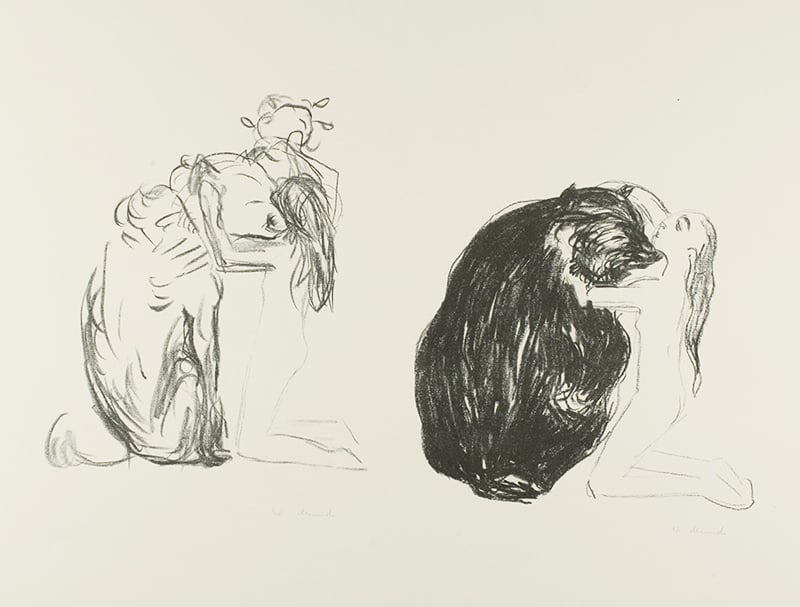Bear Witness
Can an act of interspecies violence bridge the human/animal divide? Edvard Munch, The Bear(1908/09). | Art Institute of Chicago
Edvard Munch, The Bear(1908/09). | Art Institute of Chicago o
r
d
F
a
c
t
o
r
y
In the Eye of the Wild by Nastassja Martin, translated by Sophie R. Lewis. New York Review Books, 128 pages.
Not long after Lou, the mild-mannered archivist at the center of Marian Engel’s brilliant 1976 novel Bear, starts having sex with an ursine companion, she announces her affection as a plea for violence. “I love you,” she cries. “Pull my head off.” The bear—a gentler creature than either of the human lovers of Lou’s we meet—demurs. A few trysts later, she tries him again, going further: “I am only a human woman. Tear my thin skin with your clattering claws. I am frail. It is simple for you. Claw out my heart, a grub under a stump. Tear off my head, my bear.” No luck—he merely places “a soft paw on her naked shoulder, only lovingly.” But during their final rendezvous, without invitation or warning, his claws slice her back, drawing blood. Shocked, Lou banishes him from the house. The next day, it dawns on her that something has shifted between them: “The high, whistling communion that had bound them during the summer” is gone.
If in Engel’s novel the delivery of a wound severs the outlandish relationship between woman and bear, in anthropologist Nastassja Martin’s memoir In the Eye of the Wild, it does precisely the opposite: an incident of interspecies violence forges an ineffable bond. This slim, stirring book—released in French in 2019, and out now in English, in an elegant translation by Sophie R. Lewis—begins in the autumn of 2015, hours after Martin survives an encounter with a bear on the Kamchatka Peninsula, where she has been living with the indigenous Even people. A bite from the bear leaves her badly injured, and the memoir follows her difficult rehabilitation as she moves from one hospital to another, and then back to Kamchatka, while she struggles to understand what has happened to her against the backdrop of medical bureaucracy, the concern and misapprehensions of friends and strangers alike, and ceaseless, overwhelming pain.
For Martin, violence opens up a space of unspeakable closeness.
Despite the harrowing experience at its core, In the Eye of the Wild couldn’t be further from a conventional survival memoir. Less intrepid and life-affirming than frank and brooding, it neither revels in the sensational violence of the bear attack nor offers a palatable narrative of recovery and redemption. Instead, Martin sets out to transcend familiar modes in order to let the terrible strangeness of her experience speak. Early in the memoir, she describes the “two field notebooks” she keeps—one metaphorically “diurnal,” the other “nocturnal.” The former is basically scientific, “filled with disparate notes, detailed descriptions, retranscriptions of dialogues and speeches”; the latter is “partial, fragmentary, unstable.” “I call it the black book,” Martin writes, “because I can’t really define what it contains.” In the Eye of the Wild is guided by the methods of both notebooks, oscillating between deadpan description (“My last operation is today. There is quite a crowd around my bed. The mood is festive”) and feral flights of prose:
We need to believe in the wild beings, in their silence, in their restraint; to believe in their watching, in the bare white walls and yellow bedclothes of this hospital room; to believe in the retreat that works upon body and soul in a nonplace that offers neutrality, indifference, and transversality. The formless takes shape, becomes clear, is redefined calmly, abruptly. My body after the bear after its claws, my body bloodied, reborn of death, my body filled with life, with threads and hands, my body as a wide-open world where multiple lives meet.
While the sign of the diurnal anchors Martin and keeps the book from losing itself in tortured reverie, it’s the nocturnal vision that essentially defines her project: an attempt to understand her confrontation with the bear in its singularity, disturbing ordinary conceptions of the human/animal divide. “As in the time of myths,” she writes in the opening lines, narrating the immediate aftermath of the attack, “obscurity reigns; I am this blurred figure, features subsumed beneath the open gulfs in my face, slicked over with internal tissue, fluid, and blood: it is a birth.” Soon after, she describes herself as bestialized: “The sounds I hear are enhanced, I hear like an animal, I am that wild animal . . . I am lucid beyond my human senses.” She eventually reveals that long before the attack, the Evens had called her matukha—she-bear—and afterwards, her friend Andrey dubs her medka, “marked by the bear.” According to Even tradition, a footnote explains, the medka are understood to be “half human, half bear.” In the Eye of the Wildthus takes its place within the tradition of philosophical attempts to destabilize the human/animal binary and rethink the relation, as in Jacques Derrida’s The Animal That Therefore I Am or Donna Haraway’s The Companion Species Manifesto. But while these texts often focus on animals directly under human control, meaning those with whom we’re already intimate (Derrida studies his cat, Haraway her dog), Martin’s strays far from the safe terrain of domestication, winding off the beaten path to find an unexpected affinity with a wild creature.
Whichever way the blood flows, violence between humans and other animals—from the spectacular predation of shark attacks to the mundane brutality of industrialized farming—usually emphasizes the gulf that separates us, tempting us to elevate animals into an unaccountable force of nature or reduce them to mere food. But for Martin, violence opens up a space of unspeakable closeness. In a strange echo of Marian Engel’s fictional investigation of interspecies eroticism, she calls her assailant “my bear” and repeatedly refers to his “kiss,” even as she intermingles the term with vivid descriptions of injury: “the bear’s kiss on my face, his teeth closing over me, my jaw cracking, my skull cracking.” Later, she calls this kiss “intimate beyond anything I could have imagined.” Martin sees the violence as binding her and the bear into an “incomprehensible us” in which each is an equal participant. Of course, she doesn’t deny the difference between them. But she treats this distinction as a mystery, rather than something knowable from a prior understanding of various forms of mammalian life.
Just as mysterious is the question of what made their paths cross. “Why did we choose each other?” Martin wonders. The language of choice suggests she understands her bear as a moral being. And indeed, early in the book, when Andrey asks her whether she has “forgiven the bear,” she answers as if the bear is not only the cause of her mutilation but responsible for it, describing blame (“I want to shout that I wish I had killed him”) giving way to grace (“Yes. I have forgiven the bear”). The Evens, too, see the bear as a moral agent. After Martin returns to their land to face the rupture in her body and life near the terrain where it occurred, her friend Vasya gives his own account of the bear’s choices. “Bears cannot stand to look into the eyes of a human, because they see the reflection of their own soul there,” he explains. “A bear that meets a human’s gaze always has to obliterate what he sees there.” Martin develops Vasya’s analysis:
To be the human who sees the bear (or to be the bear who sees the human) is to embody reversibility: it is to describe a face-to-face encounter in which a necessarily radical alterity is actually revealed as the greatest proximity—a space in which the one is the reflection of its double in the other world. . . . The underside of the face, the animals’ human core—this is what the bear sees in the eyes of the person whose gaze he should not meet. This is what my bear saw in my eyes: his share of humanity, the face beneath his face.
Though she never cites the French philosopher Emmanuel Levinas, Martin’s circuitous meditations on the meaning of the face evoke his ethics. Moral responsibility, Levinas argued, is not grounded in reason, sympathy, or universal law, but in the concrete experience of the face-to-face encounter, which is understood as a confrontation with the infinitude of the Other. Levinas himself investigated the place of the nonhuman in moral philosophy: his essay “The Name of a Dog, or Natural Rights” is a moving meditation on a dog named Bobby who visited him and his fellow inmates in a German prisoner of war camp. Amid the methodical dehumanization of fascism, the dog understood them as men, earning the epithet “the last Kantian in Nazi Germany.” But in a later interview, asked whether the nonhuman animal has a face and can qualify as an Other, Levinas prevaricated: “I cannot say at what moment you have the right to be called ‘face.’ The human face is completely different and only afterwards do we discover the face of an animal. I don’t know if a snake has a face. I can’t answer that question.”
Martin gradually allows her inquiry to unfold into a sort of negative theology, voiding false or insufficient attempts to understand her encounter.
Martin, at least, believes her bear can partake of the human face—and also transform it. She offers her damaged visage as an image of the way the encounter has altered her; she is, she writes, “trying to reassemble herself with the elements of something other, which have now become part of her face.” For Martin, this experience renders bodily and immediate what has long been a central theme of her research on animism; throughout the memoir, she fleetingly alludes to her study of “relations between humans and nonhumans” among the Gwich’in people in Alaska and to the Evens’ sense of “an intention unrelated to humanity” as they “l(fā)ive, feel, think, and listen in the forest.” When a well-meaning therapist attempts to validate her distress over her disfigurement by telling her “the face is our identity,” Martin seethes. “I want to explain that I’ve spent years collecting accounts of the multiple presences that can coexist within a single body,” she writes, “precisely in order to subvert this concept of singular, uniform, unidimensional identity.” But in the moment, she swallows the response and instead says simply, “I think it’s a bit more complicated.”
This understated line could serve as a motto for Martin, who spends much of the memoir frustrated by others’ attempts to make what she has undergone legible. Though she finds the most potency in the explanations offered by her Even friends and their binary-defying traditions, even these eventually wear thin. When her friend Daria tells her, “The bears give us a gift: You, by leaving you alive,” Martin is at once moved by the image of interspecies “dialogue” and repulsed by the fact that, in its attempt to translate a mysterious immediacy into an intelligible principle, it leaves behind the actual experience she shared with her bear. Perhaps, she muses,
a bear and a woman is too big an event. It’s too big not to be instantly assimilated into one system of thought or another; too big not to be co-opted by some particular discourse or at least incorporated into one. The event has to be transformed so it can be made acceptable; it must in its turn be consumed and then digested in order to make sense. Why? Because this is too terrible to imagine, because this does not fit the framework of our understanding, nor any framework, even that of the hunters living deep in the forests of Kamchatka.
Rather than dismissing the explanations of her Even friends—who are also, of course, her anthropological subjects—as empty superstition, or romanticizing them into the indisputable intuitions of all-knowing natives, she honors their insights by understanding them as useful but imperfect.
Martin gradually allows her inquiry to unfold into a sort of negative theology, voiding false or insufficient attempts to understand her encounter as she draws nearer to its inexpressible meaning without ever arriving. She comes to some of her keenest articulations by refining this sense of any answer’s inevitable deferral, presenting the confrontation as “a kind of suspension of movement, a holding back, a hiatus, a dazzlement that grips the two wild creatures caught in this ancient encounter—the meeting that cannot be prepared, nor avoided, nor escaped.” At the conclusion of his peculiar treatise The Open, the philosopher Giorgio Agamben invokes strikingly similar language as he calls for a new thinking that will “show the central emptiness, the hiatus that—within man—separates man and animal,” and invites us “to risk ourselves in this emptiness.” By accepting her own failure to capture whatever happened between her and her bear, Martin bravely honors the ineffable risk they shared.




















